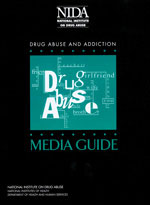Media Guide: Reliable Background for Science Writers

NIDA's Public Information and Liaison Branch has produced a Drug Abuse and Addiction Media Guide as part of the Institute's mission to close the gap between the public's impressions about drug abuse and addiction and what science has shown to be true. The guide will help science writers and editors provide accurate information in news stories that discuss or refer to drug abuse. The Media Guide provides an overview of drug abuse and addiction, details of the health effects of commonly abused drugs, a glossary, and lists of resources for statistics, breaking news on research advances, and advocacy programs.
A first printing of 1,000 copies was distributed nationwide to public information offices of NIDA grantee institutions, including central offices of the National Drug Abuse Treatment Clinical Trials Network. Members of the press may obtain a copy of the Drug Abuse and Addiction Media Guide online.
"Bridging Science and Culture" Conference
A NIDA-sponsored conference, "Bridging Science and Culture To Improve Drug Abuse Research in Minority Communities," drew more than 450 researchers, students, health care providers, community leaders, and others to Philadelphia from September 24-26. The conference was organized to disseminate research on drug abuse and addiction in racial/ethnic minority communities; to provide a forum for sharing of research needs, concerns, and opportunities; and to foster research collaboration and partnerships to improve drug abuse research in minority communities.
Then-NIDA Director Dr. Alan I. Leshner called the meeting to order and presented "Minority Health and Health Disparities Research at NIDA." On the second day of the conference, U.S. Surgeon General Dr. David Satcher gave the keynote address, "Responding to Mental Health Needs in a Diverse Health Care Environment: The Surgeon General's Prescription."
Plenary panel sessions featured such topics as "The Power of Science, Culture, and Race in Generating Knowledge and Influencing Behavior" and "Prevention Research and Minority Populations." Breakout sessions covered a range of issues from career-oriented drug abuse prevention for African-American middle school students, to comorbid conditions in racial/ethnic populations, to community approaches to prevention.
The agenda included a grant-writing workshop in which experienced grant writers offered tips for success and a simulated peer review committee meeting, where potential grant-seekers could observe how grant applications are evaluated and scored.
Compton to Head DESPR
NIDA Acting Director Dr. Glen R. Hanson has named Dr. Wilson M. Compton as Director of NIDA's Division of Epidemiology, Services and Prevention Research, beginning in March 2002. Dr. Compton has been at the Washington University School of Medicine in St. Louis, Missouri, since 1990. Currently he is director of Barnes-Jewish Hospital Chemical Dependency Services, director of the university's Master of Psychiatric Epidemiology Program, and associate professor in the Department of Psychiatry.
Walking a Good Path: 2002 Calendar

Many ancestors of today's Native Americans used the metaphor "walking a good path" to describe living honorably, with good character. NIDA's 2002 Walking a Good Path Calendar illustrates the "good path" message and encourages Native communities to turn away from influences such as drug abuse and addiction, which carry harmful consequences for the lives of Native people.
Messages of hope and inspiration are conveyed in captions for 12 monthly images of Native individuals or groups who excel by living healthy and productive lives. Each month is highlighted also by a quote from a Native American youth who has chosen to walk without drugs. NIDA developed the calendar text and images with input from other Federal agencies, Native American organizations, Urban Indian Centers, and tribal organizations. NIDA's first Good Path calendar, for 2001, was recognized by the National Institutes of Health with a Superior Plain Language Award.
